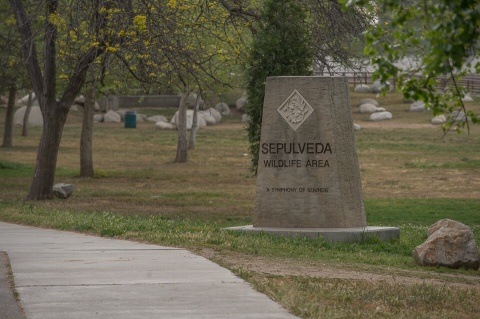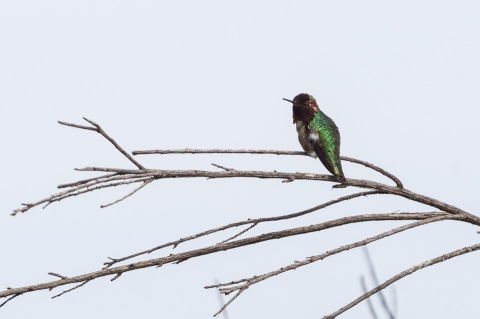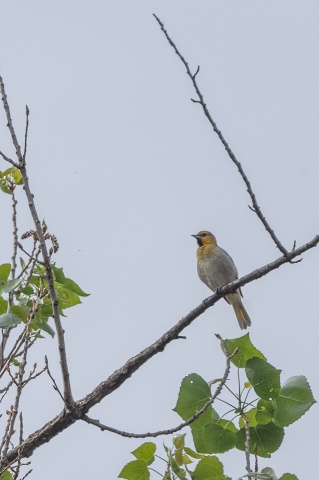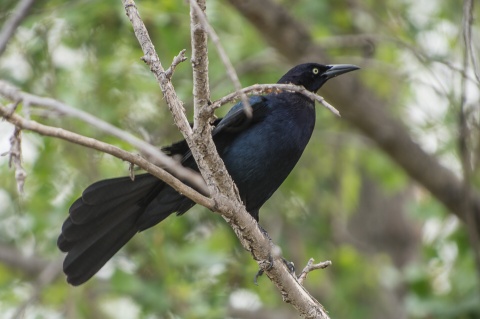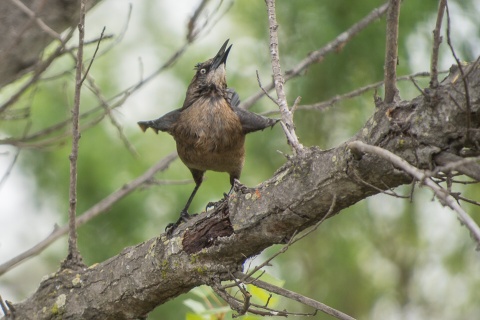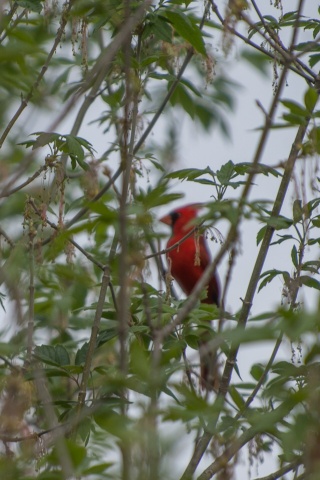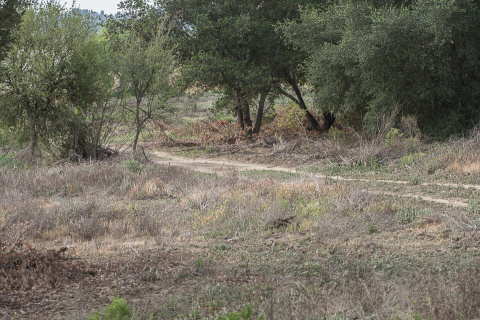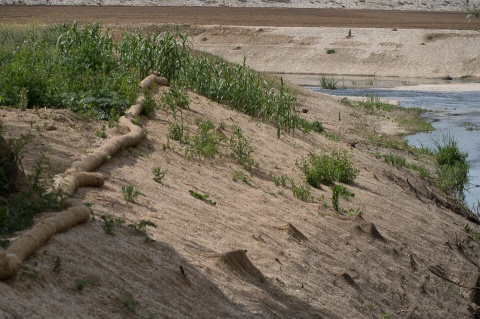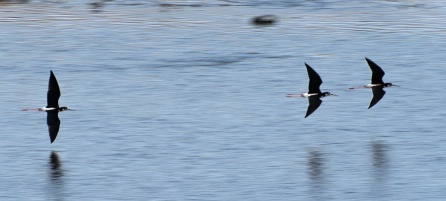About four months after the Army Corps of Engineers ripped apart 48 acres of the Sepulveda BasinWildlife Area in the San Fernando Valley, wildlife continues to surprise and amaze – even though the absence of so many birds, mammals, reptiles and amphibians still serves as a reminder that nothing in this life is ever a sure thing.
I took a recent bird walk through the North and South Reserves of the wildlife area led by Kris Ohlenkamp from the San Fernando Valley Audubon Society who, for more than 30 years, has guided monthly excursions for seasoned birders and newbies like me. (Next bird hike is slated for May 5, 2013. Click for details.)
From the moment we set foot in the North Reserve, we see birds flittering, fluttering and flapping everywhere. White crowned sparrows on the ground, yellow-rumped warblers belting out tunes on a sycamore. Is that an Allen’s or a rufous hummingbird on that branch? My fellow birders thumb through well-used books to answer each other. Half of the fun of birding, it seems, is discovering what bird it was that you actually saw or heard.
We wander through the riparian and woodland areas of this natural place that was designated in the 1970s and then later developed in the 1980s with help from Audubon and the Native Plant Society. Towering hedges of wild roses flank our pathway that runs parallel to Haskell Creek, an original tributary of the Los Angeles River.
A large “Mr. Big” birder announces, “Hey, aren’t we near where the mythical cardinal lives?” Ohlenkamp agrees but adds that it hasn’t been seen in a while, and usually folks spy that red-feathered wonder earlier in the day. In other words, don’t get your hopes up, fella.
We wander to a pond and an island where large birds preen and perch on tall trees. Red-winged blackbirds, grackles, green herons and other shorebirds cavort in the tall grasses, cattails and reeds at the pond’s edge. The cacophony of tweets, chirps, songs and trills often drowns out the sounds of the nearby freeway. IT’S LOUD. What? LOUD.
Ohlenkamp gets an osprey in his scope followed by a kestrel. Both seem to strike a pose for us as we peer at them. “Well, we are in Los Angeles after all,” someone jokes.
Then, right on cue, someone points up and gasps, “the cardinal…here!” Sure enough, high in the sycamore that deep red, pointy crest cardinal was watching us check out his bird cousins. A flurry of camera clicks and then…he was gone. (As luck would have it, Mr. Big birder failed to get a glimpse of the famed cardinal. Next time, buddy.)
Our wanderings in the North Reserve end at a darken tunnel which leads us to the South Reserve – the scene of the crime, as it were. Ohlenkamp prepares us for what we will see once we step out into the light.
The landscape change is dramatic. The near claustrophobic thickness of plant life in the north yields to an agoraphobic expansiveness of 48 acres of tree stumps, dirt mounds and wood piles. Only tall native oaks and cottonwood remain along with a stand of non-native eucalyptus. I could tell the wound is still fresh for Ohlenkamp and many local birders. It’s hard to look at the space after just experiencing a rich, noisy, lush land, only steps away.
Yes, a lack of noise. It was oddly quiet here…probably because so many birds are gone, having lost their nesting, hiding, perching and food sources. Residents and migrants will not be nesting here this year, Ohlenkamp tells us. And probably for several years to come.
“California thrashers were an abundant all-year resident of the South Reserve and they have been extirpated, just prior to their breeding season,” he says. They have not been seen here since January. The South Reserve was also nesting home to the endangered least Bell’s vireo that has gone incognito as well.
It’s hard to say specifically what else besides birds were displaced when numerous native willows, mule fat, coyote brush and elderberry trees were destroyed. No official records were kept as to a wildlife list, although an appendix to an Army Corp document lists 35 birds as common (experts say more than 200 birds species have been seen here) and only four mammals – coyote, squirrel, skunk and raccoon – but they didn’t count rabbits which we saw on our walk. No mention of reptiles, amphibians or even insects that for sure were here at one time.
Ohlenkamp points to an area for a proposed pond, lake and winter seasonal marsh, all part of the original 1981 Master Plan for the South Reserve. The 7-acre lake was previously dug but never filled with water.
In fact, it’s that original Master Plan that Audubon, along with other community groups (Sierra Club, California Native Plant Society, Sepulveda Basin Wildlife Areas Steering Committee and Encino Neighborhood Council) wants to see reinstated and used as the template to restore this section.
A meeting of those groups with the Army Corps is slated for April 23, 2013 and Ohlenkamp says he’s pretty confident that the Corps will adopt that original Master Plan. “Even so, it probably will be five years before this space is back to what it was just months ago,” he says.
Along the path to the confluence of Haskell Creek to the LA River, birders discuss the ramifications. Some think of the good that will come from this. One woman says that this tragic episode brought together community groups that normally wouldn’t know each other. That Master Plan is now high priority whereas it wasn’t just months ago.
Part of the proposed new plan would also target three species of birds (greater yellowlegs, white-faced ibis and blue-winged teal) to act as “indicator species” – canaries in the coal mine, as it were – to physically represent how the South Reserve is ecologically faring. These three birds have all been seen in the basin – as recent as this month – but not in the South Reserve. It will be a celebratory day when those flappers decide to “set up shop” and start to reclaim the area.
We head down to the merging waterways with the Sepulveda Dam framing our horizon. We watch sandpipers, killdeers and black neck stilts poking through the riverbeds. A group of coots confer with each other in the middle of the river. Three stilts rise up and zoom with break-neck precision over the water.
“Maybe it’s a good thing this happened,” one birder suggests. “Now people will pay better attention.”
Well, time is the great healer, but more than likely, time won’t erase every trace of misunderstanding and miscommunication that resulted in this man-made destruction and death of so much plant and wildlife…and maybe it shouldn’t.
– Brenda Rees, editor
– All photos by Martha Benedict (c)

